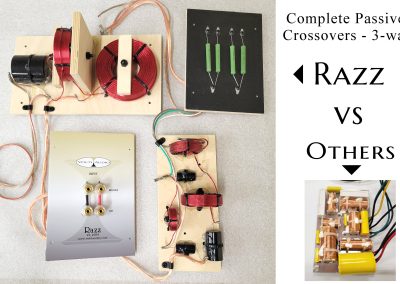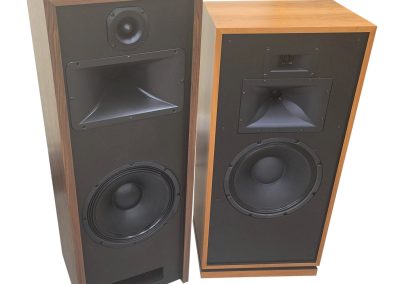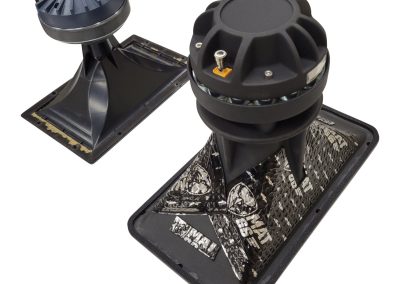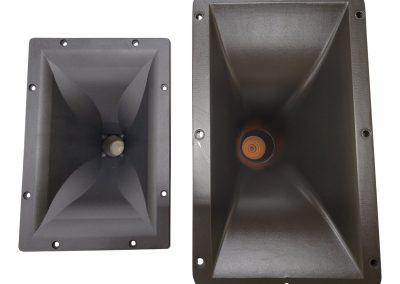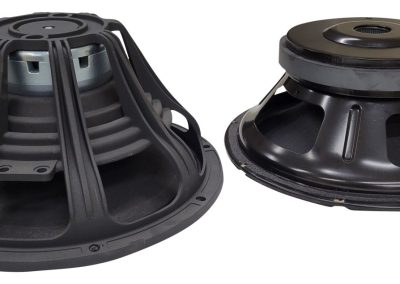Volti Audio Razz vs. Klipsch Forte Cabinet Quality
When I set out to develop a smaller horn speaker than the Rival, I did not consider how my new speaker would compare to anything from Klipsch. My focus was on a speaker in the $5K price range that had the ‘Volti Audio Sound’ and the build quality that Volti has become known for. In the end the Razz does closely resemble the size and topology of the Klipsch Forte, and comparisons between the two inevitably began to roll in after I introduced my new speaker. So I bought a pair of Klipsch Forte III speakers and listened to them, tested them, and disassembled them to inspect and test all the individual parts, including the construction quality of the cabinet. This way I could be more informed when talking to my customers.
They may look similar on the outside, and in a lot of ways they sound similar, but there is no comparison in terms of quality or refinement – The Razz is the far superior speaker. There are many practical reasons why that is the case, one of which is the quality of construction of the speaker cabinet.
The Build Quality of a Speaker Cabinet Matters
Stoutly built cabinets not only last longer, but they sound better too.
MDF (Medium Density Fiberboard) is a popular material for building speaker cabinets because it is a material that offers consistency of thickness, density, machineability, and is also easily painted. These qualities are important for larger-scale manufacturing and keeping costs in line. Most companies that use MDF for their cabinets are using a 3/4″-thick material, which is adequate for most speaker designs.
The problem I have with MDF is that it breaks down over time, loosening glued joints, swelling from normal moisture in the air, and simply does not last long enough for me. Based on my observations of old JBL cabinets that have come into my shop for restoration, I would estimate that MDF is a 30-year product, give or take a decade, depending on the conditions the speaker cabinet is exposed to over time. Fine by most people’s standards. But I’m trying to build heirloom products that will be passed down from generation to generation. I want my speakers to last 100 years or more.
Many of the manufacturers of lower priced speakers use lesser quality materials than MDF to build their cabinets. Products such as “pressboard”, are not nearly as densely made as MDF and are often thinner than 3/4″. Many of these companies use cheap glues such as hot-melt glue in their production lines to keep costs down. Cheaply built cabinets often have no internal bracing, again for cost savings. Volti Audio speakers compete directly with other brands that build their speakers this way.
I choose to use 1″-thick Baltic Birch plywood for my cabinets – a plywood that is nearly void-free, is consistent in thickness and quality, and extremely strong and durable. The 1″ thickness is significantly stouter than 3/4″ and a rarity among speaker cabinets in the marketplace. Unlike most plywood, the inner plies of Baltic Birch are made of the same material as the outer plies. You can see the quality of the material on cut edges that show off the consistent thickness and color of each individual ply. In fact, the edges are attractive enough that you will sometimes see product designs that leave them exposed and finished, rather than covering them over.
The Baltic Birch plywood parts I use to build my cabinets are CNC-cut and interlocked together, providing additional structural rigidity. Parts are glued together with polyurethane adhesives, providing a permanent bond of all the parts. My cabinets have 1″ thick internal bracing that is interlocked with the exterior panels and glued with the same adhesives. The end result is a cabinet that is far superior to most wooden speaker cabinets on the market that are built with lesser quality materials and/or construction methods. I often jokingly tell people that I could lay one of my speaker cabinets down on my driveway and drive the front tire of my Chevy 3/4-ton pickup truck up onto it without incident. A future YouTube video perhaps.
So what do you think I found when I looked inside my Forte III cabinets? Yup, the lowest quality material that a company can use to build a speaker cabinet, pressboard. I’m not sure what was used to glue these panels together, it was not visible inside the cabinet. There was no internal bracing.
If you have the opportunity to remove the woofer from the front of a Forte cabinet and touch and see what I saw when I did that to mine, you would quickly understand how cheaply built the cabinets are. Since you probably won’t ever have that opportunity, let me convey a thought I had as knelt in front of my Forte cabinet with the woofer on the floor beside me. I didn’t do it, but I’m quite sure that if I had grasped the edge of the woofer opening with both hands at about the 4 o’clock position, with one good twist I could have broken off a good chunk of the front of the cabinet. Not what I consider even a good quality cabinet.
Please understand that I’m not putting Klipsch speakers down here. That’s not my intent. I’m conveying this information so you understand that there is a significant difference in quality of the cabinets between the Razz and the Forte. I believe the quality of cabinet construction of these two speakers is at exact opposite ends of the spectrum – one being the lowest quality possible while still being able to function as a speaker cabinet and the other being the highest quality wooden speaker cabinet on the market. There is a difference in the quality of sound from these two speakers because of this. You will find the sound of the bass from the Razz to have better definition, upper bass will integrate better with the midrange, and overall there is a much more refined sound.
Razz speakers will last much longer than Forte speakers.
Over the years I’ve thought a lot about the Klipsch/Volti comparisons that people naturally make. At times I’ve wished that it would go away – for Volti Audio to have recognition without any comparison to the Klipsch brand. But let’s face it, there are not that many horn speaker companies out there, and especially ones that build products in the price points that Klipsch and Volti do. Nobody ever compares Avantgarde to Klipsch do they? If they do, they have to recognize the difference in pricing. So I’ve just embraced the fact that people are going to make comparisons. Klipsch makes a good horn speaker, but if a person wants a better horn speaker, that’s what Volti Audio is here for. I love explaining the differences between the two brands. It’s easy to see and hear the differences, and it shines a bright light on tiny Volti Audio and how we’re able to build much higher quality products than the giant Klipsch corporation.

